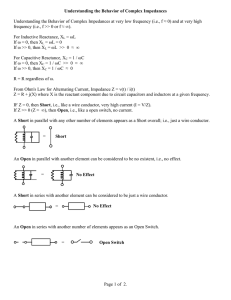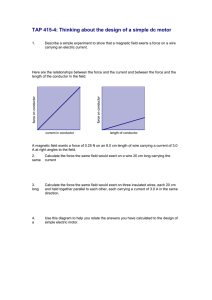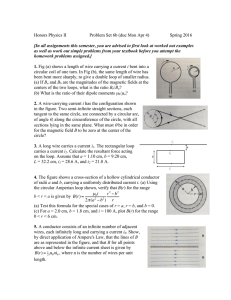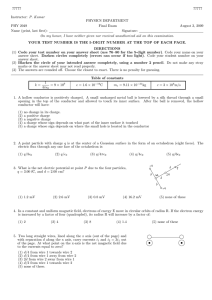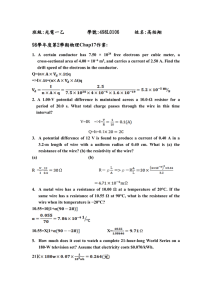Analytical Solution for the Electric Field in a Half-Space C
advertisement
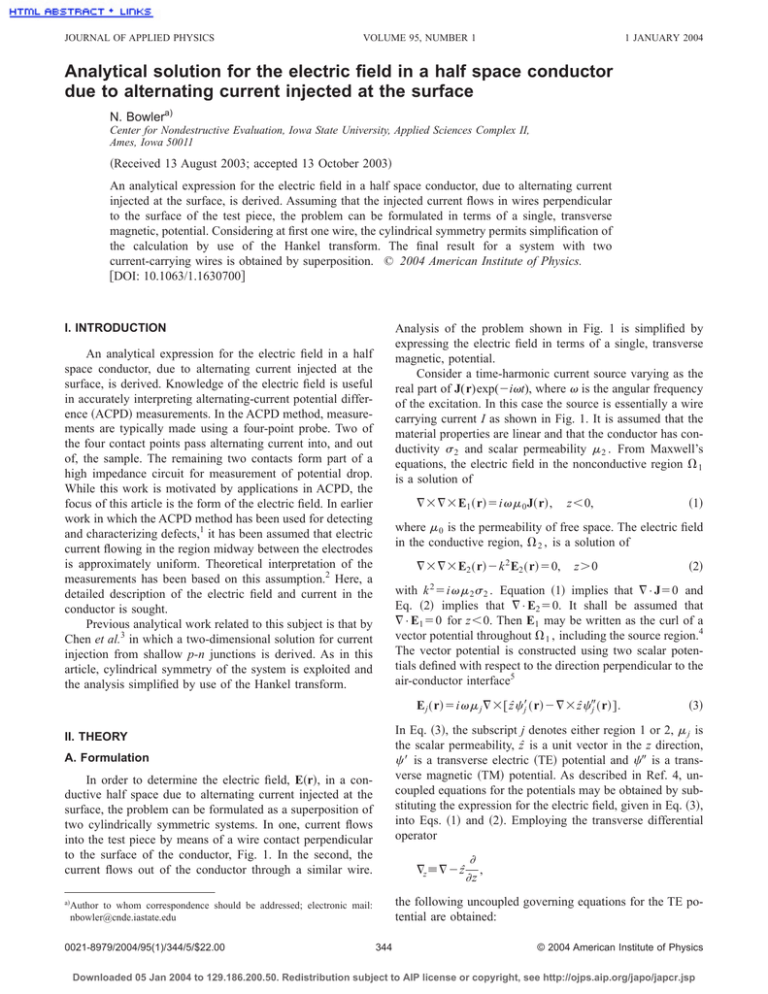
JOURNAL OF APPLIED PHYSICS VOLUME 95, NUMBER 1 1 JANUARY 2004 Analytical solution for the electric field in a half space conductor due to alternating current injected at the surface N. Bowlera) Center for Nondestructive Evaluation, Iowa State University, Applied Sciences Complex II, Ames, Iowa 50011 共Received 13 August 2003; accepted 13 October 2003兲 An analytical expression for the electric field in a half space conductor, due to alternating current injected at the surface, is derived. Assuming that the injected current flows in wires perpendicular to the surface of the test piece, the problem can be formulated in terms of a single, transverse magnetic, potential. Considering at first one wire, the cylindrical symmetry permits simplification of the calculation by use of the Hankel transform. The final result for a system with two current-carrying wires is obtained by superposition. © 2004 American Institute of Physics. 关DOI: 10.1063/1.1630700兴 I. INTRODUCTION Analysis of the problem shown in Fig. 1 is simplified by expressing the electric field in terms of a single, transverse magnetic, potential. Consider a time-harmonic current source varying as the real part of J(r)exp(⫺it), where is the angular frequency of the excitation. In this case the source is essentially a wire carrying current I as shown in Fig. 1. It is assumed that the material properties are linear and that the conductor has conductivity 2 and scalar permeability 2 . From Maxwell’s equations, the electric field in the nonconductive region ⍀ 1 is a solution of An analytical expression for the electric field in a half space conductor, due to alternating current injected at the surface, is derived. Knowledge of the electric field is useful in accurately interpreting alternating-current potential difference 共ACPD兲 measurements. In the ACPD method, measurements are typically made using a four-point probe. Two of the four contact points pass alternating current into, and out of, the sample. The remaining two contacts form part of a high impedance circuit for measurement of potential drop. While this work is motivated by applications in ACPD, the focus of this article is the form of the electric field. In earlier work in which the ACPD method has been used for detecting and characterizing defects,1 it has been assumed that electric current flowing in the region midway between the electrodes is approximately uniform. Theoretical interpretation of the measurements has been based on this assumption.2 Here, a detailed description of the electric field and current in the conductor is sought. Previous analytical work related to this subject is that by Chen et al.3 in which a two-dimensional solution for current injection from shallow p-n junctions is derived. As in this article, cylindrical symmetry of the system is exploited and the analysis simplified by use of the Hankel transform. ⵜ⫻ⵜ⫻E1 共 r兲 ⫽i 0 J共 r兲 , z⬍0, where 0 is the permeability of free space. The electric field in the conductive region, ⍀ 2 , is a solution of ⵜ⫻ⵜ⫻E2 共 r兲 ⫺k 2 E2 共 r兲 ⫽0, z⬎0 共2兲 with k 2 ⫽i 2 2 . Equation 共1兲 implies that ⵜ•J⫽0 and Eq. 共2兲 implies that ⵜ•E2 ⫽0. It shall be assumed that ⵜ•E1 ⫽0 for z⬍0. Then E1 may be written as the curl of a vector potential throughout ⍀ 1 , including the source region.4 The vector potential is constructed using two scalar potentials defined with respect to the direction perpendicular to the air-conductor interface5 E j 共 r兲 ⫽i j ⵜ⫻ 关 ẑ ⬘j 共 r兲 ⫺ⵜ⫻ẑ ⬙j 共 r兲兴 . 共3兲 In Eq. 共3兲, the subscript j denotes either region 1 or 2, j is the scalar permeability, ẑ is a unit vector in the z direction, ⬘ is a transverse electric 共TE兲 potential and ⬙ is a transverse magnetic 共TM兲 potential. As described in Ref. 4, uncoupled equations for the potentials may be obtained by substituting the expression for the electric field, given in Eq. 共3兲, into Eqs. 共1兲 and 共2兲. Employing the transverse differential operator II. THEORY A. Formulation In order to determine the electric field, E共r兲, in a conductive half space due to alternating current injected at the surface, the problem can be formulated as a superposition of two cylindrically symmetric systems. In one, current flows into the test piece by means of a wire contact perpendicular to the surface of the conductor, Fig. 1. In the second, the current flows out of the conductor through a similar wire. ⵜz ⬅ⵜ⫺ẑ , z the following uncoupled governing equations for the TE potential are obtained: a兲 Author to whom correspondence should be addressed; electronic mail: nbowler@cnde.iastate.edu 0021-8979/2004/95(1)/344/5/$22.00 共1兲 344 © 2004 American Institute of Physics Downloaded 05 Jan 2004 to 129.186.200.50. Redistribution subject to AIP license or copyright, see http://ojps.aip.org/japo/japcr.jsp J. Appl. Phys., Vol. 95, No. 1, 1 January 2004 N. Bowler 345 B. Scalar potential 1. Governing equation and boundary conditions FIG. 1. Cross section of a wire, radius a, carrying current I in contact with a half space conductor. The system is cylindrically symmetric. ⵜ 2 ⵜ z2 ⬘1 共 r兲 ⫽⫺ⵜ• 关 ẑ⫻J共 r兲兴 , 共 ⵜ 2 ⫹k 2 兲 ⵜ z2 ⬘2 共 r兲 ⫽0, z⬎0. z⬍0, 共4兲 共5兲 For the TM potential ⵜ 2 ⵜ z2 1⬙ 共 r兲 ⫽⫺ẑ•J共 r兲 , 共 ⵜ ⫹k 2 2 z⬍0, 兲 ⵜ z2 2⬙ 共 r兲 ⫽0, z⬎0. 共6兲 共7兲 It is assumed that the potentials vanish as 兩 r兩 →⬁. 4 For Eqs. 共5兲 and 共7兲 to be satisfied it is sufficient that 2⬘ and 2⬙ satisfy the Helmholtz equation. Similarly, in source-free regions, ⬘1 and ⬙1 satisfy the Laplace equation according to Eqs. 共4兲 and 共6兲. Assume that the wires are perpendicular to the conductor surface and the radius of the wire, a, is sufficiently small that J⫽J z ẑ, 共8兲 z⬍0. This is certainly true sufficiently far from the conducting half space but it will be assumed true as z→0⫺. Later, the limit a→0 will be taken. Hence the assumption expressed in Eq. 共8兲 is reasonable. Then, since ẑ⫻J⫽0, the source term for the TE potentials in Eqs. 共4兲 and 共5兲 vanishes, and hence ⬘j ⫽0,j⫽1,2. Consequently, only the TM potential is required to describe the field. If the current-carrying wires are not perpendicular to the conductor surface, the TE component of E exists in the conductor. The cylindrical symmetry of the system is lost and, in general, E has three components. A new potential is defined as follows: ⌿ j ⫽ⵜ z2 ⬙j . 共9兲 Then Eqs. 共6兲 and 共7兲 become ⵜ 2 ⌿ 1 共 r兲 ⫽⫺ẑ•J共 r兲 , 共 ⵜ 2 ⫹k 2 兲 ⌿ 2 共 r兲 ⫽0, z⬍0, z⬎0. 共10兲 共11兲 From Eq. 共3兲, retaining only the TM potential, the two components of the electric field in the conductor can be expressed E z 共 r兲 ⫽i ⌿ 共 r兲 , 共12兲 2 ⬙ 共 r兲 , E 共 r兲 ⫽⫺i z 共13兲 where and z are coordinates of the cylindrical system. The subscript 2 is dropped in Eqs. 共12兲 and 共13兲, and from here on. It is not convenient to express E in terms of ⌿. Rather, E will be obtained from Eq. 共13兲 by means of relationship 共9兲. Now solve Helmholtz Eq. 共11兲 for the scalar potential ⌿ in the conductor, subject to certain boundary conditions at its surface. If Eq. 共11兲 is written in cylindrical coordinates and ⌿ is independent of azimuthal angle , then 冉 冊 2 2 1 ⫹ ⫹ ⫹k 2 ⌿ 共 ,z 兲 ⫽0. 2 z 2 共14兲 Appropriate boundary conditions can be obtained by considering the normal component of the current density at the conductor surface. At z⫽0, J z ⫽0 for ⬎a, outside the region of the wire contact. For ⭐a, the current density matches that in the wire 再 I , a2 J z 共 ,0兲 ⫽ 0, ⭐a, 共15兲 ⬎a. In Eq. 共15兲 it has been assumed that the current density in the wire is uniform with respect to the radial coordinate . This assumption is reasonable if the radius of the wire is somewhat smaller than the electromagnetic skin depth in the wire. Later, the limit a→0 will be taken. In the limiting case it is reasonable to assume uniform current density in the wire, even for arbitrary frequency. Now write Eq. 共15兲 in terms of ⌿ to obtain the following boundary condition: ⌿ 共 ,0兲 ⫽C, where 共16兲 再 I ⭐a, 2, C⫽ 共 ka 兲 0, ⬎a. 共17兲 2. Solution The solution of Eq. 共14兲 subject to the boundary condition expressed in Eqs. 共16兲 and 共17兲 proceeds as follows. The radial variable, , can be conveniently removed by application of the Hankel transform.3 The Hankel transform of order m of a function f ( ) is given by6,7 f̃ 共 兲 ⫽ 冕 ⬁ 0 f 共 兲 J m共 兲 d . 共18兲 The Hankel transform is self-inverse, hence f 共 兲⫽ 冕 ⬁ 0 f̃ 共 兲 J m 共 兲 d . 共19兲 Now apply the zero-order Hankel transform to Eq. 共14兲, making use of the following identity6 ( f ( ) is assumed to be such that the terms J 0 ( ) f ( )/ and f ( ) J 0 ( )/ vanish at both limits兲: 冕 冋 冉 ⬁ 0 2 2⫹ 冊 册 1 f 共 兲 J 0 共 兲 d ⬅⫺ 2 f̃ 共 兲 . 共20兲 The result is a one-dimensional Helmholtz equation Downloaded 05 Jan 2004 to 129.186.200.50. Redistribution subject to AIP license or copyright, see http://ojps.aip.org/japo/japcr.jsp 346 J. Appl. Phys., Vol. 95, No. 1, 1 January 2004 冉 冊 2 ⫺ ␥ 2 ⌿̃ 共 ,z 兲 ⫽0, z2 z⬎0, N. Bowler 共21兲 wherein ␥ ⫽ ⫺k . For ␥ the root with positive real part is taken. The general solution of Eq. 共21兲 is 2 2 2 ⌿̃ 共 ,z 兲 ⫽A 共 兲 e ⫺ ␥ z ⫹B 共 兲 e ␥ z 共22兲 but here B( ) is zero since ⌿ must remain finite as z→⬁. Applying the inverse transform to ⌿̃ then yields ⌿ 共 ,z 兲 ⫽ 冕 ⬁ 0 A 共 兲 e ⫺␥zJ 0共 兲 d . 共23兲 A( ) will now be sought from the boundary condition 共16兲. At z⫽0, C⫽ 冕 ⬁ 0 A 共 兲 J 0共 兲 d . 共24兲 A( ) is extracted from Eq. 共24兲 by using the Fourier–Bessel integral 共Ref. 8, result 6.3.62兲 which may be expressed as f 共 z 兲⫽ 冕 ⬁ 0 J m共 ␣ z 兲 ␣ d ␣ 冕 ⬁ 0 f 共 兲 J m共 ␣ 兲 d . 共25兲 Multiply both sides of Eq. 共24兲 by 兰 ⬁0 J 0 ( ⬘ ) d . Reverse the order of integration on the right-hand side and simplify, by use of Eq. 共25兲, to give A 共 兲 ⫽C 冕 a 0 J 0共 兲 d . 共26兲 The upper limit of integration in Eq. 共26兲 is a since C⫽0 for ⬎a. Evaluation of the integral in Eq. 共26兲 共Ref. 9, result 9.1.30兲 yields the following result for A( ): A共 兲⫽ I J 1共 a 兲 . k2 a 共27兲 Now insert the above expression for A( ) into Eq. 共23兲 to obtain ⌿ 共 ,z 兲 ⫽ I k 2a 冕 ⬁ 0 e ⫺␥zJ 1共 a 兲 J 0共 兲 d . 共28兲 The integral in Eq. 共28兲 cannot be evaluated analytically for arbitrary z, but putting z⫽0 it is found that 共Ref. 10, result 6.512.3兲 ⌿ 共 ,0兲 ⫽0, ⬎a, 共29兲 in accordance with boundary condition 共16兲. As mentioned earlier, the limit a→0 will now be taken. The reason for this is that the radius of the contact point between the wire and the conductor surface may be assumed small in the present context, where the separation of the current-carrying wires is assumed large compared with their radius. It was necessary to include a in the calculation up to this point in order that the current density in the wire be finite. In Ref. 9, result 9.1.7 the result lim J 共 z 兲 ⬃ z→0 冉冊 z 2 1 ⌫ 共 ⫹1 兲 allows the following limit to be found: J 1共 z 兲 1 ⬃ . 2 z→0 z lim Hence, lim A 共 兲 ⬃ a→0 I . 2k2 共30兲 If A( ), as given in Eq. 共30兲, is now inserted into Eq. 共23兲, the following expression for ⌿ is obtained: ⌿ 共 ,z 兲 ⫽ I 2k2 冕 ⬁ 0 e ⫺␥zJ 0共 兲 d . 共31兲 In expression 共31兲 it is understood that the limit a→0 has now been taken. An analytical result for the integral in Eq. 共31兲 is given in Ref. 7, result 8.2.23 共reproduced in the Appendix兲. It is found that ⌿ 共 ,z 兲 ⫽⫺ I ikz ikr e 共 1⫺ikr 兲 , 2 共 ikr 兲 3 z⬎0, 共32兲 wherein r 2 ⫽ 2 ⫹z 2 . C. Electric field Analytic forms for the two components of the electric field in the conductor, Eqs. 共12兲 and 共13兲, will now be obtained. It is a trivial matter to obtain E z from result 共32兲 since E z and ⌿ are simply related by the factor i , Eq. 共12兲 E z 共 r兲 ⫽⫺ i I ikz ikr e 共 1⫺ikr 兲 , 2 共 ikr 兲 3 z⬎0. 共33兲 From Eq. 共29兲 E z 共 ,0兲 ⫽0, ⬎0, 共34兲 as required by the boundary condition on J z at the surface of the conductor, away from the current injection point. To obtain E requires more work. First, apply the zeroorder Hankel transform to Eq. 共9兲 to establish ˜ ⬙ 共 ,z 兲 ⫽⫺ ⌿̃ 共 ,z 兲 . 2 共35兲 Then, from Eq. 共31兲, ⬙ 共 ,z 兲 ⫽⫺ I 2k2 冕 ⬁ 0 1 e ⫺␥zJ 0共 兲 d . 共36兲 This integral cannot be evaluated since it diverges logarithmically. The divergent behavior is due to the fact that only one current-carrying wire is considered at this stage in the analysis. Physically, the current must flow in a closed loop. If an additional wire is considered, in which current flows out of the conductor, the integral corresponding to that in Eq. 共36兲 is well defined. Here, the mathematical development of an expression for the electric field is simplified by considering only one wire. The process of superposition to obtain a physical result for two wires carrying opposing currents, as shown in Fig. 2, is done later. Downloaded 05 Jan 2004 to 129.186.200.50. Redistribution subject to AIP license or copyright, see http://ojps.aip.org/japo/japcr.jsp J. Appl. Phys., Vol. 95, No. 1, 1 January 2004 N. Bowler 347 To obtain E , it is necessary to differentiate ⬙ with respect to . Applying the differential operator to Eq. 共36兲 and reversing the order of differentiation and integration gives I ⬙ 共 ,z 兲 ⫽ 2k2 冕 ⬁ 0 e ⫺␥zJ 1共 兲 d . 共37兲 An analytic result for this integral is available in Ref. 7, result 8.4.9, and is reproduced in the Appendix. Then 冉 冊 ⬙ 共 ,z 兲 I z ⫽ e ikz ⫺ e ikr , 2 2k r z⭓0. 共38兲 Strictly, relation 共38兲 as obtained by use of Ref. 7, result 8.4.9 is valid only for z⬎0. Putting z⫽0 in Eq. 共37兲 and invoking Ref. 10, result 6.511.1, however, shows that ⬙ 共 ,0兲 I ⫽ , 2 k 2 共39兲 which may be obtained by putting z⫽0 in Eq. 共38兲. Hence, relation 共38兲 holds for z⭓0. Referring to Eq. 共13兲, it is necessary to take the derivative of Eq. 共38兲 with respect to z in order to obtain E . Finally, E 共 r兲 ⫽ 再 冋 冉 iI 1 e ikr 1 共 ikz 兲 2 e ikz ⫺ 1⫹ 1⫺ 2 ik ikr ikr ikr 冊 册冎 . 共40兲 Considering the forms of E z and E as given in Eqs. 共33兲 and 共40兲, respectively, it can be seen that the electric field exhibits correct behavior in certain simple cases. On the axis of the cylindrical system, which coincides with the axis of the current-carrying wire, E (0,z)⫽0. E z is symmetric with respect to and both E z and E →0 as r→⬁. In the far field, the electric field is dominated by the first term in Eq. 共40兲 and the associated current density is J 共 r兲 ⬇ k 2 I e ikz , 2 ik as r→⬁. III. CONCLUSION An elegant analytical expression for the electric field in a half space conductor due to alternating current injected at the surface has been derived. The method of solution, in which the Hankel transform is used, suggests a solution for a layered half space, or plate, in the form of a series expansion. Explicitly, the expression for the scalar potential, Eq. 共31兲, becomes a series of similar terms in which the exponents may include the thickness of the layer or plate. This is the subject of a future article. ACKNOWLEDGMENT This work was supported by the NSF Industry/ University Cooperative Research program. APPENDIX The following identities were used in evaluating the integrals which appear in Eqs. 共31兲 and 共37兲, respectively. From Ref. 7, result 8.2.23, for y⬎0 冕冑 ⬁ 共43兲 xe ⫺ ␣ 冑x 2 ⫹  2 0 ⫽ J 0 共 xy 兲 冑xydx ␣ 冑y 冑 2 2 e ⫺  y ⫹ ␣ 共 1⫹  冑y 2 ⫹ ␣ 2 兲 , 共 y ⫹ ␣ 2 兲 3/2 2 共A1兲 with the restrictions Re ␣⬎0 and Re ⬎0. Also from Ref. 7, result 8.4.9 冕冑 ⬁ 0 1 x ⫽ 共42兲 It can be shown that the result of this article reduces to the form given in Eq. 共42兲 by noting that J r ⫽(r/ )J and letting k→0 in Eq. 共40兲. Equivalently, Eq. 共33兲 can be used with J r ⫽(r/z)J z . Consider now the system shown in Fig. 2. The electric field in the conductor can be obtained by superposition of fields separately associated with the two current-carrying wires, as determined above. In the conductor, the total electric field ET is given by ET 共 r兲 ⫽E共 r⫹ 兲 ⫺E共 r⫺ 兲 , due to alternating current injected and extracted by contact wires at x⫽⫾S. In Eq. 共43兲, r ⫾ ⫽ 冑(x⫾S) 2 ⫹y 2 ⫹z 2 and the components of E are given in Eqs. 共33兲 and 共40兲. 共41兲 If the far field current density, given in Eq. 共41兲, is integrated over a cylindrical surface of large radius extending from z ⫽0 to ⬁, the result is simply I, as it should be. Last, in the static limit of direct current, in which k→0, the current density in the conductor radiates uniformly from the point of injection I . J r 共 r兲 ⫽ 2r2 FIG. 2. Cross section of a half-space conductor and two current-carrying wires. The plane y⫽0 is shown. e -␣ 冑x 2 ⫹  2 1 冉 冑y J 1 共 xy 兲 冑xydx e ⫺ ␣ ⫺ ␣ 冑y 2 ⫹␣2 e ⫺ 冑y 2 ⫹ ␣ 2 冊 , 共A2兲 with the same restrictions on y, ␣ and . 1 W. D. Dover, F. D. W. Charlesworth, K. A. Taylor, R. Collins, and D. H. Michael, in Eddy-Current Characterization of Materials and Structures, edited by G. Birnbaum and G. Free 共American Society for Testing and Materials, Philadelphia, 1981兲, pp. 401– 427. 2 M. McIver, Proc. R. Soc. London, Ser. A 421, 179 共1989兲. 3 P.-J. Chen, K. Misiakos, A. Neugroschel, and F. A. Lindholm, IEEE Trans. Electron Devices ED-32, 2292 共1985兲. 4 J. R. Bowler, J. Appl. Phys. 61, 833 共1987兲. 5 W. R. Smythe, Static and Dynamic Electricity 共McGraw–Hill, New York, 1968兲. 6 C. J. Tranter, Integral Transforms in Mathematical Physics 共Chapman and Downloaded 05 Jan 2004 to 129.186.200.50. Redistribution subject to AIP license or copyright, see http://ojps.aip.org/japo/japcr.jsp 348 J. Appl. Phys., Vol. 95, No. 1, 1 January 2004 Hall, London, 1974兲. Tables of Integral Transforms, edited by A. Erdélyi 共McGraw–Hill, New York, 1954兲, Vol. II. 8 P. M. Morse and H. Feshbach, Methods of Theoretical Physics, Part I 共McGraw–Hill, New York, 1953兲. 7 N. Bowler 9 Handbook of Mathematical Functions with Formulas, Graphs and Mathematical Tables, edited by M. Abramowitz and I. A. Stegun 共Dover, New York, 1972兲. 10 I. S. Gradshteyn and I. M. Ryzhik, Table of Integrals, Series and Products, 6th ed. 共Academic, New York, 2000兲. Downloaded 05 Jan 2004 to 129.186.200.50. Redistribution subject to AIP license or copyright, see http://ojps.aip.org/japo/japcr.jsp
